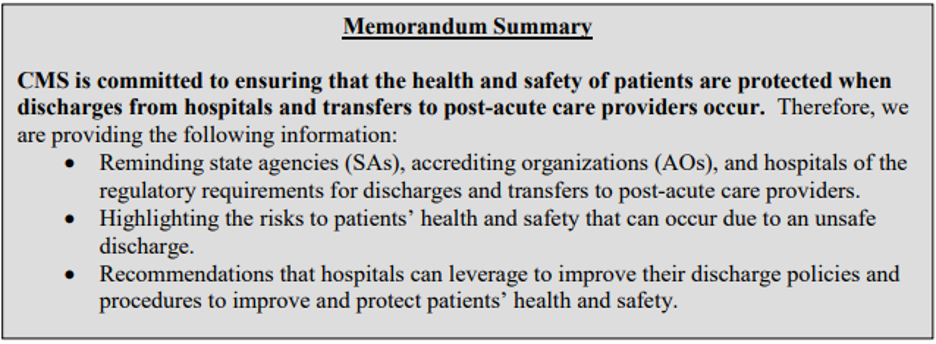Mary Madison, RN, RAC-CT, CDP
Clinical Consultant – Briggs Healthcare
On June 6, 2023, CMS posted QSO-23-16-Hospitals.

When a patient is discharged from a hospital, it is important to provide their post-acute provider and caregivers as applicable with the appropriate patient information related to a patient’s treatment and condition in order to decrease the risk of readmission or an adverse event. For example, when a patient is discharged to a post-acute care (PAC) provider such as a skilled nursing facility (SNF) or home health agency (HHA), these providers must receive accurate and complete information related to the patient’s condition and treatment (e.g., diagnoses and medications) in order to protect and improve the patient’s health and safety.
CMS has identified areas of concern related to missing or inaccurate patient information when a patient is discharged from a hospital. These areas of concerns include missing or inaccurate information related to:
• Patients with serious mental illness (SMI), complex behavioral needs, and/or substance use disorder (SUD). Information related to patient’s acute condition may be included, but information related to the patient’s underlying diagnoses of SMI and/or SUD is not included. Additionally, specific treatments that were implemented to help manage these conditions while in the hospital are omitted from patient information upon hospital discharge and transfer to the PAC provider, such as additional supervision that was provided throughout the patient’s hospital stay (or was provided for some of the hospital stay, but discontinued prior to discharge (e.g., 24- 48 hours before discharge));
• Medications, such as an incomplete comprehensive list of all medications that have been prescribed to a patient during, and prior to, their hospital stay. Common omissions also include patient diagnoses or problem lists, clinical indications, lab results, and/or clear orders for the post-discharge medication regimen. Medication information omissions have been most commonly reported for psychotropic medications and “hard” prescriptions for narcotics (i.e., provided on paper, not electronic, as required by law);
• Skin tears, pressure ulcers, bruising, or lacerations (e.g., surgical site(s), skin conditions noted upon hospital admission and/or acquired during hospitalization), including orders or instructions for cultures, treatments, or dressings;
• Durable Medical Equipment, such as Trilogy, CPAP/BiPap or high-flow oxygen which are used for respiratory treatments and skin healing equipment for example mattresses, wound vacuum machine for treatment of a variety of wounds including surgical wounds, pressure ulcers, diabetic ulcers, etc.;
• A patient’s preferences and goals for care, such as their choices for treatment or their advance directives for end-of-life care; and
• Communication (with PAC providers and/or caregivers) about a patient’s needs at home, or how their home environment may impact their ability to maintain their health and safety after discharge from the SNF (e.g., risk of falls, family or caregiving involvement/availability, homelessness, etc.).
When the above issues occur, PAC providers are not properly prepared to care for new admissions, and caregivers are not properly prepared to care for their loved ones at home. Also, PAC providers may not be equipped or trained to care for certain conditions that apply to patients whose information they were not previously informed of by the hospital and have accepted for transfer and admission. Not only can this place the patient’s health at risk, it can also put the health and safety of other residents (in the patient’s home or in a SNF), as well as provider staff, at risk. These situations can cause avoidable readmissions, complications, and other adverse events. Finally, when an individual’s preferences for end-of-life care are not known, they may receive treatments that are unnecessary or inconsistent with their wishes.
Therefore, we are reminding state agencies (SAs), accrediting organizations (AOs), and hospitals that when patients are discharged (per 42 CFR 482.43), CMS regulations require hospitals to, “have an effective discharge planning process that focuses on the patient’s goals and treatment preferences and includes the patient and his or her caregivers/support person(s) as active partners in the discharge planning for post-discharge care.” Also, “the hospital must discharge the patient, and also transfer or refer the patient where applicable, along with all necessary medical information pertaining to the patient’s current course of illness and treatment, post-discharge goals of care, and treatment preferences, at the time of discharge, to the appropriate post-acute care service providers and suppliers, facilities, agencies, and other outpatient service providers and practitioners responsible for the patient’s follow-up or ancillary care.” When conducting surveys, SAs and AOs should be alert to the common issues identified above and ensure these discharges are occurring in a compliant and safe manner.
Thank you, CMS for this reminder. Whether you’re an acute or PAC provider, the focus must be on preparing and providing proper patient care. We’re all in this – life and health – together.
